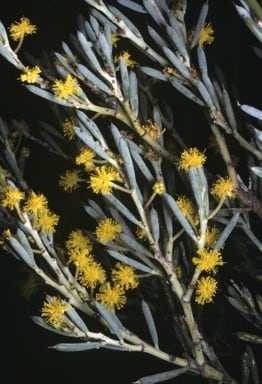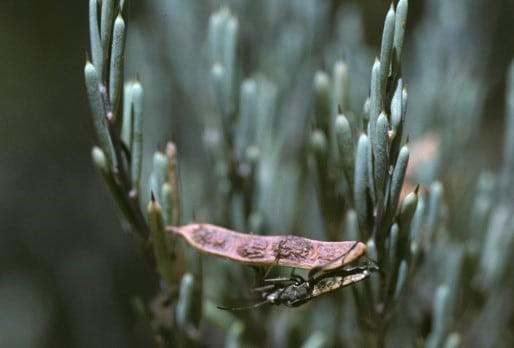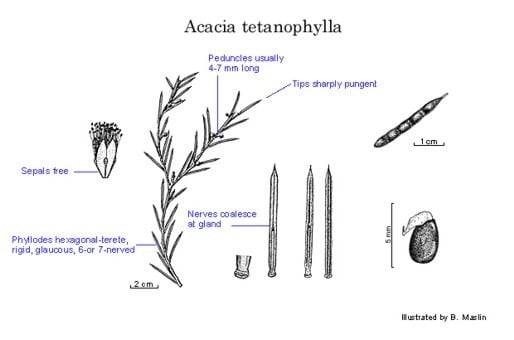Acacia tetanophylla Maslin
WATTLE
Acacias of Australia
Family
Fabaceae
Distribution
Occurring sporadically from near Chillilup (just S of Stirling Ra.) ESE to near Ravensthorpe, south-western W.A. Outliers occur near Nyabing (c. 100 km N of Chillilup) and near Lake King (c. 60 km N of Ravensthorpe).
Description
Shrub 0.6–2 m high. Branchlets glabrous, sometimes appressed-puberulous. Phyllodes ascending to erect, ±straight, usually hexagonal-terete (fresh), often slightly flattened and furrowed between nerves when dry, usually 15–40 mm long and 1–1.5 mm wide, subulate-pungent, rigid, glaucous, green when young, glabrous, 7-nerved with the 2 adaxial nerves coalescing near gland 5–15 mm above base. Inflorescences simple; peduncles usually 4–7 mm long, glabrous; basal bract, rostriform, caducous; heads globular, usually golden and 3.5–4 mm diam., usually 13–18-flowered. Flowers 5-merous; sepals free. Pods linear to narrowly oblong, usually to 4 cm long, 2–4 mm wide, slightly undulate, firmly chartaceous, glabrous. Seeds longitudinal, oblong-elliptic to ovate, 2.5–3 mm long, shiny, dark brown to black; aril subterminal.
Habitat
Grows in (often rocky) sand or clay.
Specimens
W.A.: Hamersley R., Fitzgerald R. Natl Park, M.I.H.Brooker 2750 (AD, BRI, PERTH); 17.7 km W of Ravensthorpe near Phillips R. crossing, B.R.Maslin 3466 (AD, CANB, K, MEL, NSW, NY, PERTH); 16 km E of Lake King, K.Newbey 9481-1 (MELU, PERTH).
Notes
A well-marked variant occurs in the Dragon Rocks Reserve, c. 70 km WNW of Lake King (e.g. B.R.Maslin 6309, PERTH). It differs quantitatively in a number of character states and probably should be accorded formal recognition at the species level. It has glaucous, obscurely nerved, small phyllodes (6.5–14 mm long, 0.8–1.5 mm diam.) that are not sulcate in drying, short peduncles 2–4.5 mm long, bearing lemon yellow heads 2.5 mm diam. with about ten flowers each and short pods (to 2.7 cm).
A member of the ‘A. sulcata group’, perhaps nearest A. dura but distinguished by its prominent, long, slender, straight phyllode-cusp. Also possibly related to A. hystrix and A. declinata; superficially similar in phyllodes to A. pharangites.
FOA Reference
Data derived from Flora of Australia Volumes 11A (2001), 11B (2001) and 12 (1998), products of ABRS, ©Commonwealth of Australia
Author
R.S.Cowan
This identification key and fact sheets are available as a mobile application:
URL: https://apps.lucidcentral.org/wattle/
© Copyright 2018. All rights reserved.










